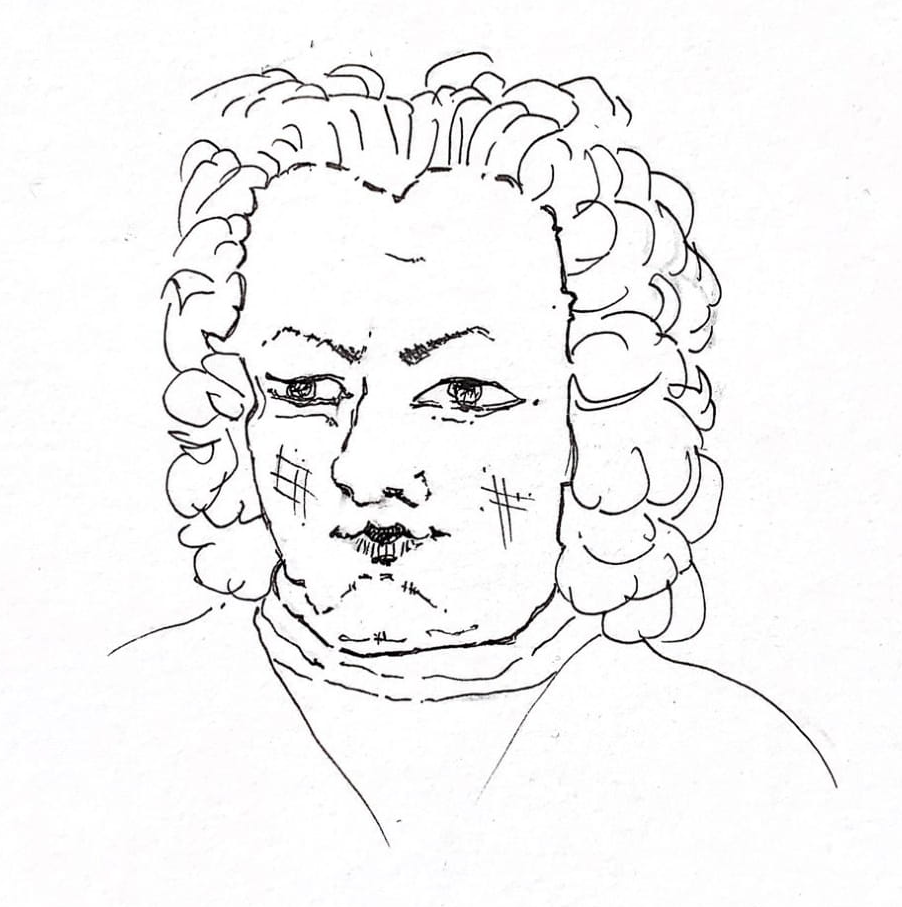Bach Cantata BWV 7
The feast of the Nativity of St John The Baptist
Thursday 24th June 2021…
…and the gospel for this day is concerned with just that. However, the text to this cantata may lead us to think of it as all about the baptism of Jesus. -but think again.
Within, are many references to baptism-y things, spirit-y and water-y, both pointing, not to Jesus, or so much even to John, but to the facts, formats, functions and formations, of this new requirement.
1/Chorale:
,Christ unser Herr zum Jordan kam‘, ‘Christ our Lord came to the Jordan’
This place, Jordan, a point of arrival, is perhaps seen by Bach as the point of the start of this, -a stoical journey.
Strong rhymical drives, reminiscent of the ‘Royal’ French overture, albeit without its faster middle section, are underpinned by a persistent rising and falling three-quarter arpeggio…a ‘wave motif’? and this, more often than not, is seen, throughout the continuo part, and there, supplemented with dotted material, from elsewhere.
Concertante violins and oboe d’amore, both alone and together, at times, separate away from the main band.
The ‘wave-motif’ is heard in and throughout inner parts.
There is a feeling of a job-needing-to-be-done and that now is the time to get on with it.
Two long verses are intoned by tenors, in crotchets and minims, brining a sense of time slowly passing. The other voices surround and support with free polyphonic and imitative textures, a concertante violin and sometimes the rest of that concertante group, supporting, with gentle winds and rippling waves.
Listen out for:
,Da wollt er stiften uns ein bad‘, ‘There He would institute for us a bath.’
leading into:
,Ersäüfen auch den bittern Tod‘, ‘..to drown bitter death.’
Certainly a stoical choral introduction, which moves slowly and certainly, with little change in its progress.
A proclamation of intent.
Bach gives time between lines of text for us to listen and to learn, -and to make our own, all important, secret responses to those revelations.
‘Through His own blood and wounds, new life is effected.’
2/Aria:
A bass voice and an agile continuo ‘cello.
,Merkt und hört, ihr Menschenkinder.‘
‘Listen and hear, children of men.’
Water, we are told, is needed for baptism, yet, that is not all sufficient… Spirit is also required, -and not only in that Holy sense, but also in that un-holy sense, of determination, resolve and loads of tenacity, all of this written carefully into our ‘cellist’s part, where opening stoical leaps and bounds, are followed by the splishings, sploshings and splashings of water, being liberally poured.
A middle section sees our singer take on the role and tone of a tough teacher and we are taught very clearly that, ‘God’s word and God’s spirit baptise and cleanse sinners.’
3/recit: At the Jordan river, a voice form heaven is heard,
‘This is my beloved Son, adopt Him as your saviour.’
The singer reaches his highest, naturally, at the the high throne of heaven and the hearing of teaching.
4/Aria: The Father, the Son and the Holy Spirit all make their voices heard, The Son, because He has purchased us with His blood, The Spirit, because He has come in the form of a dove, and The Father- -because He can.
This three-part-Trinity takes to the stage in the guise of two violins from the concertante and a voice.. and in this guise we are taught that this Trinity is responsible for this baptism, that is prepared for us.
Bach chooses a spritely imitative jig-like bounce, to set off, -and off-set, the two, -before the third joins in, to animate the intensity of these three and their profound message.
At bar 7 of the introduction, we find ourselves rising ever upwards.
This is a serious message and one that we need to hear.
Our singer dances about and turns around, with the two, finding common ground in their shared quavers and constructive dialogue when he slurs his words, in duplets, -not forgetting the occasional semiquaver, of course.
Note how Bach, in his meticulous attention to detail, drops the pitch of the voice, down, colouring the word ,Mensch’, or (Hu)man.
Human solutions are low on Bach’s scale…
All three, like doves, circle, sometimes alone, sometimes in a pair and sometimes as The three, every combination and recombination of this trinity -and its variants, being covered in music.
5/Recitativo: -with arioso, where, after resurrection, Jesus said to His disciples:
‘Go into all the world and teach..’
The orchestra follows the voice at ‘Go forth..’, but at ‘(whoever believes) shall be justified and saved.’, the orchestra anticipates the voice, -justification and salvation are gifted to us, before we can do anything.
6/Aria:
‘Mankind: believe in this grace, so that you do not die in sin.. or perish in the pit of hell.’
An austere plea to take up, through faith, this offer of baptism.
Voice + continuo are answered with a short ritornello, giving us all time to consider these stark choices. -in fact, Bach gives five such opportunities.
An awkward three-and-a-half-bar phrase sets out some bad news:
‘Human deeds and sanctity count for nothing before God’
and a unifying six-bar-phrase, with vocal emphasis on ,verdammlich’, or ‘damnable’, makes the point that, a choice must be made.
7/choral:
‘The eye can only water, as it is poured, by humans, -but faith alone can comprehend the power.’
The text is very carefully coloured musically, and with a tasteful and tight harmony, -hints of modalism and shades of ambiguity abounding, when, mention of Adam’s bequeathed wounds to us are articulated in the text and eradicated by the blood of Christ.
The spare 9th line is beautifully incorporated into the whole, with an E major colour that eradicates, finally, nicely -and for-ever, any sins that we may feel, leave us in peril.
